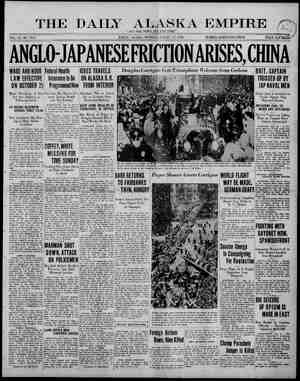The Daily Alaska empire Newspaper, August 15, 1938, Page 5
You have reached the hourly page view limit. Unlock higher limit to our entire archive!
Subscribers enjoy higher page view limit, downloads, and exclusive features.
THE DAILY ALASKA EMPIRE, MONDAY, AUGUST 15, 1938. 29 ? g/ —br THE ASSOCIATED PRESS w @ The Story Behind a 90th Anniversary l Fixed bayonets sweep Nippon’s flag into a shell-smashed Chinese village. . . . Lights burn at 10 Downing $treet while Britain grapples with an empire crisis. . . . An heiress elopes with a hog caller. . . . The Department of Justice uncovers a new nest of inter- national spies . . . and even as these events occur detailed accounts stream over 285,000 miles of Associated Press news wires to 1,400 member newspapers all over the nation. Do you know the 90ear story of this AP? On a black November night in 1811 young Samuel Topliff shoved his rowboat into Boston harbor to learn the cause of distant cannonading. His perilous trip—guns of a British fleet were sounding the prelude to the War of 1812—was the first systematic attempt to gather news. Out of that plucky beginning grew the first important news gathering organization, founded in 1848. It was called The Associated Press. The year 1938 marked the 90th anniversary of that name in newspaperdom. In Topliff’s time there were few daily newspapers; they printed little news because they had no way of obtaining it. There were no big cities, no telegraph, telephone, oceanic cable, wireless. As the country grew, mechanical means for transmitting news developed apace with a mount- 3 ing demand for public information. The years, however, showed one potential flaw in the early - d news gathering system. It was a proprietary commercial organization and there was the danger 7 Twenty-seven Presidents ago, young Sam Topliff braved Boston’s dark that private interests might prostitute the news for personal profit. harbor in a rowboat to report on one of the encounters out of which grew . 8 s 4 4 ¢ g 5 the Wac of 1812 I 1835, sailing sloobs repldcatisowBonts and raced each One far-sighted publisher, Victor Lawson of the Chicago Daily News, recognized tl:is | other to deliver news. Still later, carrier pigeons became news hawks. Staunch believer in the need for an uncontrolled press, he led what has become known as *“The Revolution of 1893.” This ended the old private news monopoly. In its place, Lawson and his allies set up the new Associated Press— first and only world-wide, non-profit, cooperative news gathering organization, dedicated to ideals of accuracy and impartiality. In 1900 AP’s maximum news output was 15,000 words a day to 612 members. Today 1,400 member newspapers are linked in a 285,000 mile wire network which transmits 200,000 words every 24 hours. Once the AP staff was a mere handful. Today 100,000 men and wo- men, directly or indirectly, help gather and transmit each day’s report. Once $10,000 covered AP’s budget. Today it exceeds $10,000,000 annually, yet the organization makes no profits, declares no dividends. In every country, in every state, news bureaus operate. In virtually every hamlet on the globe there is a correspondent. Bureau staffs range from a single reporter to as many as 500 employes. All this is a far cry from Topliff’s primitive day. Not the least of today’s wonders is Wirephoto, which transmits AP pictures from coast to coast with the speed of light. A Board of Directors, composed of eighteen publishers, is responsibl : to the membership. In active charge of the world-wide organization is the General Manager. Throughout newspaperdom he is familiarly known as"The Managing Editor of The World.” i No matter where news breaks—a reporter is there to get the story. . . . Tireless reporters and editors work at candle-lighted desks in darkened flood areas. They're equally alert at political conventions. Coverage of elections is so accurate that the government accepts AP’s findings weeks in advance of the official count. Over an ever-widening web, news hummed across the nation. The San Francisco earth- quake occurred in 1906, The at:to around which the AP news staff congregated is out- moded today, but it was ultra:nodern then. Now even foreisn correspondents use the latest method of transportation-- che airplane. % 4\“"( Thousands of automatic machines rush all the news to waiting front pages. The machines never stop; the offices never close. Through the greatest transmission feat of modern times, 4 ;f/ WIREPHOTO machines also send pictures over parallel cir- i i R 5 G cuits, Thus, news and pictures now ride the wires side by side i g 5 NEE ¢ The first AP foreign correspondent entered Europe in 1866. Today, American-trained reporters + dostited o eanidt millions of newspaper readers only minutes Photographic history was rn.adc during thf Civil War with pictures of soldiers on the muih‘ hBu: everywhere cover and cable every picce of foreign news to New York for relay over the vast after any event, anywhere. as lat.e as 1890, papers cfms:duc.d news pictures a fad. Now, hund.rtd‘s of cameramen n‘ : eir wire network of member papers. One correspondent penetrates the Ethiopian war zone; another . lives in perilous places, side by side with reporters. In war-torn Ethiopia, one cameraman fol lows turns delivery man to reach the Duke of Windsor and his bride in their guarded chateau. the troops; another rides a steel cable for his pictures of a domestic disaster. NG MATTER WHERE NEWS BREAKS—A REPORTER IS THERE TO GET THE STORY....

